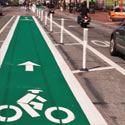Saturday, March 12, 2011
Bicycle facility design guides
AASHTO Bike Guide: The official bicycle facility design guide is the AASHTO Guide to the Development of Bicycle Facilities published in 1999. Discussions regarding update of the 1999 version of the guide began as early as 2003. A group within AASHTO, the American Association of State Highway and Transportation Officials, oversees revisions to the guide based on "proven and tested national best practices." Toole Design Group led the effort to produce a new draft version of the revised bike guide, which was released for review and comment in Feb 2010.At the USBR 1 meeting recently held in DC, staff from AASHTO provided an update on the status of the draft guide. Over 1500 comments were received, so many that another consultant, Midwest Research Institute, was hired to research and respond to each comment. AASHTO hopes to have a revised draft by May or June. The approval process will begin with balloting of member organizations, 2/3 of whom must vote in favor of approval for adoption. This will take 3-6 months. Publication is possible by the end of the year.
Even the revised Bike Guide will not include many innovative bicycle facilities. According to comments on the revised guide submitted by the Association of Pedestrian and Bicycle Professionals (APBP)
While the Guide must be grounded in research, it must also include the latest and best observations and guidance on innovative designs. We hope that the Guide will highlight the need for funded research, but we recognize that some level of guidance is appropriate as the research catches up to the state of the practice."
The list of facilities includes buffered bike lanes, contra-flow bike lanes, left-side bike lanes, bike lanes with reverse angled parking, bike lanes at freeway interchanges, bike lanes at roundabout approaches, bike boulevards, shared lane markings in a variety of settings, climbing bike lanes, signalized intersections designed to meet bicyclists' needs, two-way paths adjacent to roads (under certain conditions), and path/roadway intersections.
The list of facilities includes buffered bike lanes, contra-flow bike lanes, left-side bike lanes, bike lanes with reverse angled parking, bike lanes at freeway interchanges, bike lanes at roundabout approaches, bike boulevards, shared lane markings in a variety of settings, climbing bike lanes, signalized intersections designed to meet bicyclists' needs, two-way paths adjacent to roads (under certain conditions), and path/roadway intersections.
 |
| One-Way cycle track |
The NACTO Urban Bikeway Design Guide is based on the experience of the best cycling cities in the world. The designs in this document were developed by cities for cities, since unique urban streets require innovative solutions. Most of these treatments are not directly referenced in the current versions of the AASHTO Guide to Bikeway Facilities or the Manual on Uniform Traffic Control Devices (MUTCD), although many of the elements are found within these documents.
The Federal Highway Administration has recently posted information regarding approval status of various bicycle related treatments not covered in the MUTCD, including many of the treatments provided in the NACTO Urban Bikeway Design Guide. All of the NACTO Urban Bikeway Design Guide treatments are in use internationally and in many cities around the US.
The Federal Highway Administration has recently posted information regarding approval status of various bicycle related treatments not covered in the MUTCD, including many of the treatments provided in the NACTO Urban Bikeway Design Guide. All of the NACTO Urban Bikeway Design Guide treatments are in use internationally and in many cities around the US.
Labels: aashto, bike guide, nacto
Comments:





Post a Comment